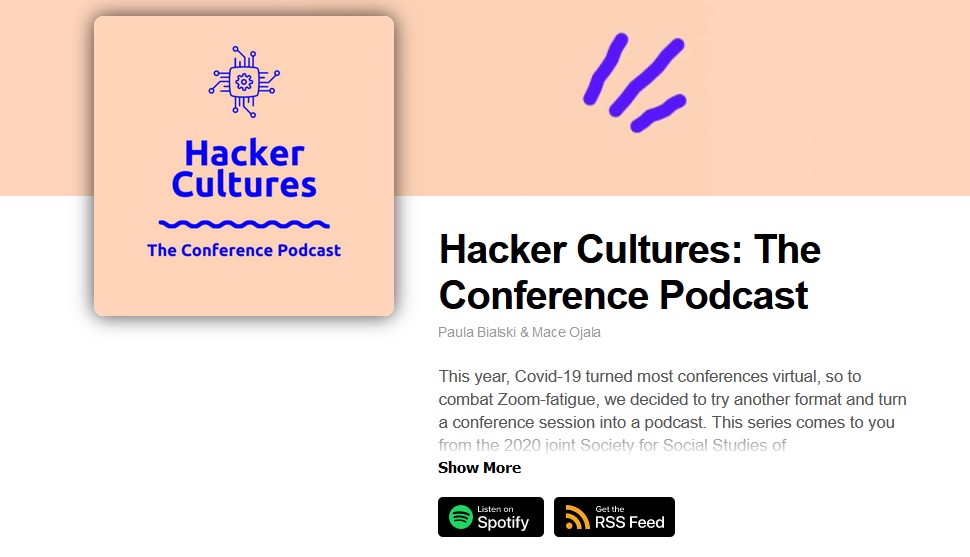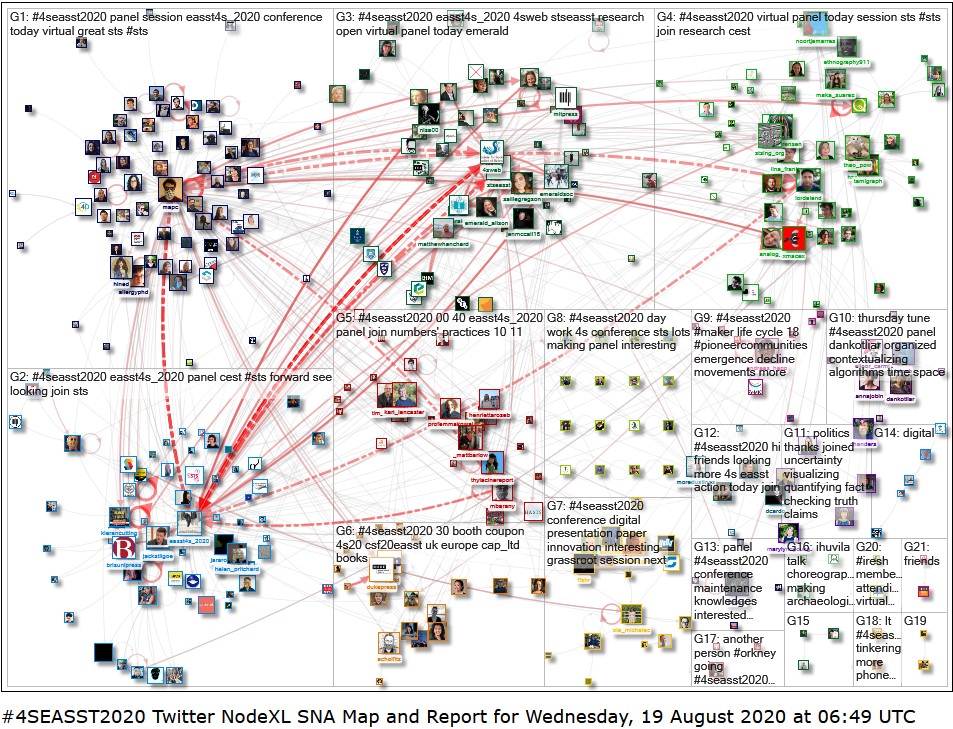On May 17, the EASST president Ulrike Felt announced that cancelling the EASST/4S conference “was never seen as a real option” and that they are looking for the “best socio-technical option to go virtual”. The conference organisational committee promised to “make the best of the situation” implying the digital format to be less favourable for a conference. The transformation of a standard conference into a digital conference eschews the question what a good conference is. The organisers tried to maintain the structure of conventional conferences, successfully establishing a stable presentation framework, but missed some chances to explore new digital formats – which, however, a few sessions applied.
Digital conferences are often discussed regarding their pros (cheaper, recordable, family friendly, eco-friendly, Corona proof, etc.) and their cons (time zones, no immediate ‘liveness’, exhausting, etc.) with a tendency towards a ‘better than nothing’ sentiment. The business world discussed digital conferences from the beginning of the Covid pandemic with great openness. A Forbes writer lowered expectations, stating that organisers “may not have the know-how or capacity to throw a 5-star digital event together on the first round”.1 The same applies to participants, who sometimes struggled with the tools used for the conference. I must say I was astonished that basic ‘Zoom skills’ are not yet part of everybody’s presentation repertoire. Consequently, the next digital EASST/4S (if and when performed) will benefit from our learnings this year and make an even better conference.
However, digital conferences are no technical fix to professional meetings and exchange. The EASST/4S conference gathering – as well as other (digital) conferences – hereby offered insights into the limits of digitalization. Evidently, not everything that constitutes a good on-site conference can be digitalised. Especially the informal interpersonal communication, the ‘immediacy’ and ‘liveness’ that accompanies a physical participation, or even the ‘feeling’ of being in a foreign city and eating the local dishes – these physical experiences make the travel worth, and are all excluded when meeting online. The mediated ‘liveness’ of TV, live stream, social media or digital conferences is part of society’s current ‘reality’ (van Es 2017) but it lacks the sensorial and emotional components of being on-site and in a local event. However, mediated live events are to some extent more accessible (no travel, usually less costs, etc.) than on-site events (travel, expenses, time investment, etc.).
Digital conferences seem to be similar to digital objects. They are both ‘real’ and ‘material’ (Rogers 2013, S. 19). An online conference paper, a tweet, a like-action, etc. are all objects that inhabit our world. Consequently, a digital conference is not ‘representation’ of the ‘real world’ but a manifestation of socio-technical interaction itself. However, a digital conference is different from a non-online, on-site conference, as it requires different infrastructures and interactions. An online conference can imitate a conventional conference by having a speaker and Q&A format, but there is still a need to adapt all known formats. For instance, voting tools for polls on topics or other choice making procedures are much easier online whereas informal communication is much harder to achieve. Using the known interaction formats of presentation and discussion is a possibility but not in any case the best choice.

The organisers cared for stability of knowledge transfer when they offered participants the opportunity to record presentations, which everyone could watch before the respective sessions or in retrospect to the sessions. The conference program contained Zoom links for every one of the 400 sessions which were only accessible for those who paid the conference fee. This fee, which could not be reduced due to cheap online communication, had to be used for paying already made reservations for Prague, cross-finance other expenses, and buying software, apart from other reasons (as stated by Ulrike Felt). The next digital conference would assumable be cheaper due to experience and infrastructure build up this year.
Although all conference sessions were live (some using recorded presentations in addition), the practices and performances of video conferences were improvable. The organisation committee expected to “see various novel approaches coming from the Making and Doing presenters”. However, many sessions I visited were standard Zoom meetings with a simple mode of presentation and discussion. I can only speculate that session chairs saw the standard Zoom meeting as sufficient or were overwhelmed with organising different formats. The conference succeeded in giving a good structure for those Zoom meetings, which worked out fine most of the time but were exhausting for a whole of four days. Some sessions made use of recorded presentations to avoid bandwidth problems. When the chairs asked everybody to click on a link for a recorded presentation, a strange situation emerged: Everybody in the Zoom meeting was quiet while watching the presentation video in their private browser video. In addition, presenters watched themselves in their own video. These awkward moments of co-watching a video while watching the other Zoom participants watching their video stream could be avoided in the future by either going live with all presentations or making watching the videos prior to the sessions mandatory. Live streaming is not comparable to an in-person experience but it is preferable to recorded talks.
Live streaming requires adequate platforms. Even though STS scholars are very aware of “platform economies” (Kenney und Zysman 2016) and their power, they are hard to avoid building a communication structure for a live event. Streaming of live subplenaries and recorded presentations was supported with a proprietary version of SlidesLive, which ran YouTube in the background. Following and commenting ongoing discussions worked well on the technical as well as the side of discussion flow. However, the platform might not have been the best choice because participants e.g. from China could not access the service – without hacking. Commercial digital platforms offer the best service with robust data traffic and easy to use software, but they set limits to the accessibility. The accessibility limit in the case of China was even for political reasons, whereas other limits were just non optimal usage or lack of bandwidth.
Most of the formal activities of conventional conferences – such as sessions, subplenaries, and even exhibits – were transferred to Zoom or SlidesLive/YouTube streams. New formats were mainly explored within sessions. One interesting session (by Paula Bialski und Mace Olja) organised a podcast on their panel topic “Hacker Cultures”. The content about nostalgia in hacking, cyber security experts job changes, or experiences in hackerspaces, was interesting and not unusual STS content, but the format of a well-produced podcast was very refreshing. The podcast is still available and I listened to the interviews of the presenters on a bike ride. It distracts one from the usual Zoom fatigue.

According to the Twitter livestream, this EASST/4S was mostly normal: Chairs advertised their sessions, presenters their presentations, and some minor discussions took place on social media. However, a few local STS communities announced their ‘public viewing’ of conference events. It seems that some tried to fight the isolation one felt participating in a large conference within a tiny office. According to colleagues, the workload one had to wrestle with during conference week felt different on a digital conference. An on-site conference in Prague would have distracted academics from their always too busy schedule and would have kept them much more ‘in the moment’, to borrow a phrase from Yoga philosophy.

I emphasised before that digital conferences should be seen as an object in itself and not a representation of a ‘real’ event. A digital event comes with a different, more mediated live experience. These events have the tendency to be more accessible and are based on different practices and infrastructures. I would like to close with some ideas for future digital conferences:
-
- A lobby could be a meeting point where you might find old conference acquaintances and come back to every time you are not participating in an event. This could be a Zoom meeting or a simple chat or take place with the help of other digital tools.
- ‘Idea speed dating’ could bring back the randomness of interactions: Shuffle all participants and pair them in a breakout session for 7 minutes.
- Assigning a random conference buddy with whom you should have a virtual coffee break or lunch meeting with.
- Using a business matching platform (somehow similar to a romantic dating platform) to find colleagues with similar academic interests (e.g. via https://converve.com/).
- Conference packages with refreshments to be consumed at digital coffee tables could be sent via mail to all participants in advance (although this is costly and comes with organisational obstacles).
- These practices might fulfil some of the needs conference participants have in one way or another. There are grounds on which we can be optimistic that future digital conferences will give an integrated live experience, which is more accessible, affordable, and eco-friendly than an on-site conference.
1 Daniel Newman: Events Are Going Digital: Should Your Company Follow? Apr 6, 2020, https://www.forbes.com/sites/danielnewman/2020/04/06/events-are-going-digital-should-your-company-follow/
Bibliography
Kenney, Martin; Zysman, John (2016): The Rise of the Platform Economy. In: Issues in Science & Technology (Spring), S. 61–69.
Rogers, Richard (2013): Digital methods. Cambridge, Mass., London: The MIT Press. Online verfügbar unter http://search.ebscohost.com/login.aspx?direct=true&scope=site&db=nlebk&db=nlabk&AN=601408.
van Es, Karin (2017): Liveness redux: on media and their claim to be live. In: Media, culture, and society 39 (8), S. 1245–1256. DOI: 10.1177/0163443717717633.